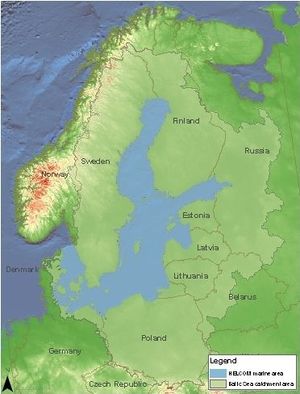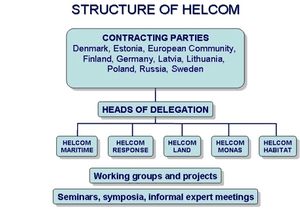Difference between revisions of "HELCOM (Helsinki Commission) and Helsinki Convention"
(→Applied Principles) |
|||
| Line 79: | Line 79: | ||
These Principles are generally applied to improve the situation of the Baltic Sea environment: | These Principles are generally applied to improve the situation of the Baltic Sea environment: | ||
| − | + | ===Responsibility=== | |
| − | + | In order to restore the ecosystem of the Baltic Sea area and preserve its ecological balance the Contracting Parties shall individually or jointly take all appropriate legislative, administrative or other measures to prevent and eliminate pollution. | |
| − | |||
| − | |||
| − | |||
| − | |||
| − | |||
| + | ===The precautionary principle=== | ||
| + | Preventive measures must be taken whenever there are reasonable grounds to believe that substances or energy directly or indirectly introduced into the marine environment might harm human health, living resources or marine ecosystems, or damage amenities or interfere with other legitimate uses of the sea. | ||
| + | |||
| + | |||
| + | ===Best Environmental Practices and Best Available Technologies=== | ||
| + | [[Best Environmental Practices (BEP)]] and [[Best Available Technologies (BAT)]] will be promoted by the Contracting Parties to prevent the pollution of the Baltic Sea. Additional measures shall be taken if the consequent reductions of inputs do not lead to acceptable results. | ||
| + | |||
| + | ===The "polluter pays" principle=== | ||
| + | should serve as the economic basis for the control of environmentally harmful activities, emphasizing the importance of responsibility by forcing polluters to pay for the true costs of their activities. | ||
| + | |||
| + | ===Monitoring=== | ||
| + | Emissions from both [[point sources]] and [[diffuse sources]] into water and the air should be measured and calculated in a scientifically appropriate manner by the Contracting Parties. | ||
| + | |||
| + | ===Avoiding risks=== | ||
| + | Implementing the Helsinki Convention should neither result in transboundary pollution affecting regions outside the Baltic Sea area, nor involve increases or changes in waste disposal or other activities that could increase health risks. Any measures taken must not lead to unacceptable environmental strains on the atmosphere, soils, water bodies or groundwater. | ||
==Priorities== | ==Priorities== | ||
Revision as of 09:03, 7 August 2012
HELCOM works to protect the marine environment of the Baltic Sea from all sources of pollution, and to restore and safeguard its ecological balance through intergovernmental co-operation between:
- Sweden
- Finland
- Russia
- Estonia
- Latvia
- Lithuania
- Poland
- Germany
- Denmark
- the EU
Belarus and the Ukraine take part in the process as observers. As Figure 1 shows, they, like also the Czech Republic, are part of the catchment area of the Baltic Sea.
HELCOM works as an environmental policy-maker for Baltic Sea concerns, but also as the body to coordinate and supervise the implementation by the Contracting Parties. In addition to that, HELCOM provides information about the environmental status and trends in the Baltic Sea Area, the measures and their efficiency.
Contents
History
In 1974 seven states were bordering the Baltic Sea. The Helsinki Convention of this year was the first agreement taking into account all the sources of pollution to the Baltic Sea at once. It entered into force on 3 May 1980.
Due to changes in the political situation and developments in international environmental and maritime law, a new convention was signed in 1992. The European Community completed the membership of all now bordering states. After ratification the Convention entered into force on 17 January 2000. It covers not only the Sea area itself, but also inland waters in the catchment and the Sea bed. Therefore, also land-based pollution as one important source for pollution to the Sea is subject to management by HELCOM.
You can download the recent version of the Convention as a pdf-Document [1].
Organization
The Commission meets annually and decides unanimously on recommendations on the marine environment. Each Contracting party is given 1 vote in the Commission. The EU may vote for its member states if these do comply or are not present. These recommendations are then put into law by all respective countries of the Contracting Parties. Extraordinary meetings of the Commission are enforced after request from one Contracting Party and the endorsement of another one.
In addition, ministerial meetings are also held at least every 3 years, leading to Ministerial Declarations.
While the chairmanship rotates between the countries every two years (in the alphabetical order in English), the secretariat has a constant address in Helsinki, Finland. Here, at the headquarters of the organisation there are 13 people employed at the moment, including one Executive Secretary. The Secretariat supports the working structure of HELCOM, which is shown in Figure 2.
Besides the meetings of the Contracting Parties, there is an extra board of the Heads of Delegation and the 5 main working groups of HELCOM as subsidiary bodies of the Commission:
- The Monitoring and Assessment Group (HELCOM MONAS)
- The Land-based Pollution Group (HELCOM LAND)
- The Nature Protection and Biodiversity Group (HELCOM HABITAT)
- The Maritime Group (HELCOM MARITIME)
- The Response Group (HELCOM RESPONSE)
These five groups implement the policies and strategies in the different aspects of HELCOM´s work and in return propose issues to discuss at the Heads of Delegation meetings. At these meetings, which are held at least twice a year, the proposals of the groups have to be approved before they are passed on to the Commission.
The general tasks of the Heads of Delegations meetings are to:
- supervise implementation of Commission policy
- make policy and strategy proposals to the Commission
- provide guidance to and support the Executive Secretary in programme development and management
- carry out all other tasks which they may be given by the Commission
Observers
As mentioned above, Belarus and the Ukraine are official HELCOM observers. In addition there are many more international governmental and non-governmental organisations observing the process of HELCOM´s work e.g. at its meetings.
- Governments and intergovernmental organisations [2]
- International non-governmental organisations [3]
Goals
The main objective is a to create a healthy Baltic Sea environment with diverse biological components functioning in balance, resulting in a good ecological status and supporting a wide range of sustainable economic and social activities.
Applied Principles
These Principles are generally applied to improve the situation of the Baltic Sea environment:
Responsibility
In order to restore the ecosystem of the Baltic Sea area and preserve its ecological balance the Contracting Parties shall individually or jointly take all appropriate legislative, administrative or other measures to prevent and eliminate pollution.
The precautionary principle
Preventive measures must be taken whenever there are reasonable grounds to believe that substances or energy directly or indirectly introduced into the marine environment might harm human health, living resources or marine ecosystems, or damage amenities or interfere with other legitimate uses of the sea.
Best Environmental Practices and Best Available Technologies
Best Environmental Practices (BEP) and Best Available Technologies (BAT) will be promoted by the Contracting Parties to prevent the pollution of the Baltic Sea. Additional measures shall be taken if the consequent reductions of inputs do not lead to acceptable results.
The "polluter pays" principle
should serve as the economic basis for the control of environmentally harmful activities, emphasizing the importance of responsibility by forcing polluters to pay for the true costs of their activities.
Monitoring
Emissions from both point sources and diffuse sources into water and the air should be measured and calculated in a scientifically appropriate manner by the Contracting Parties.
Avoiding risks
Implementing the Helsinki Convention should neither result in transboundary pollution affecting regions outside the Baltic Sea area, nor involve increases or changes in waste disposal or other activities that could increase health risks. Any measures taken must not lead to unacceptable environmental strains on the atmosphere, soils, water bodies or groundwater.
Priorities
- eutrophication, especially the contribution of agriculture
- hazardous substances
- land transport sector
- maritime transport sector, including carrying out the Baltic Strategy
- environmental impacts of fishery management and practices
- protection and conservation of marine and coastal biodiversity
- implementation of the Joint Comprehensive Environmental Action Programme and HELCOM Recommendations
Achievements
Since the beginning of the 1980s the Helsinki Commission has been working to improve the Baltic marine environment, largely through some 200 HELCOM Recommendations.
Successes during this period include:
- Lower discharges of organic pollutants and nutrients from point-sources.
- A 20-25% overall reduction in the emissions of oxygen-consuming substances (BOD) from the 132 originally identified hot spots since the early 1990s, with about 50 hot spots deleted from the list.
- Fewer beaches closed for bathing, thanks to improvements in the treatment of industrial and municipal wastewater.
- Significant reductions in atmospheric nitrogen deposition.
- Dramatic reductions in emissions of organo-halogen compounds such as toxic dioxins and furans.
- National regulations banning hazardous substances like PCB and DDT.
- Stricter controls on industry (permits are now compulsory for industrial emissions).
- Improved joint monitoring of the state of the marine environment.
- The recovery of seal and white-tailed eagle populations.
- Better special legislation to prevent the pollution of the Baltic Sea by shipping, developed together with the International Maritime Organization (IMO).
- Measures to eliminate all illegal discharges by ships into the Baltic Sea.
- A major international plan to combat marine pollution, with active co-operation involving all the Contracting Parties through HELCOM.
Projects
In addition to the work carried out by the five main groups, specific programs can be launched. These projects deal with topics that can not be covered by the five main groups in this way. Therefore, these projects have defined time limits and Terms of Reference.
Projects can be suggested by all parts of HELCOM organisation and can be funded internally or externally. For a list of all running projects click here [4].
Baltic Sea action plan
The HELCOM Baltic Sea Action Plan is an ambitious programme to restore the good ecological status of the Baltic marine environment by 2021. It applies the Ecosystem Approach to the management of human activities. The document can be downloaded in pdf-Format [5].
Joint HELCOM/OSPAR Work Programme on Marine Protected Areas
At the first joint ministerial meeting of the Helsinki and OSPAR commissions (JMM) in Bremen an 25-26 June 2003 the above named programme was adopted. The purpose of the work programme is to ensure that by 2010 there is an ecologically coherent network of well managed marine protected areas (MPAs) for the maritime areas of both HELCOM (Baltic Sea) and OSPAR (North East Atlantic).
Official site
More detailed information can be gathered at the Official Homepage, including downloads of a number of assessments of Baltic Sea issues, listings of all meetings and much more [6].
Please note that others may also have edited the contents of this article.
|

